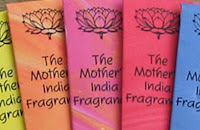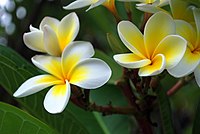 |
| Second review - scroll down for earlier |
I just reviewed
Nag Champa Tru Blu, which was one of the last things that Paul Eagle of
Happy Hari was working on before his death on Christmas Day 2016. The intention was to produce a
nag champa supposedly better than the Satya Nag Champa that was on sale at the time. Out of interest I compared it with a Satya Nag Champa from around the same period (2017).
 |
Happy Hari Tru Blu top
Satya Nag Champa below |
The Satya has a generous amount of still soft charcoal paste rolled around a plain machine-cut bamboo splint, and then given a fluffy coating of melnoorva/masala powder. The scent is very similar, though much softer - less clear, and not as sweet or joyful. Very attractive, though. And really, very, very similar.
On the burn the Tru Blu is pure - not smoky, and with few or no off notes. Bits of basic wood scent do dominate briefly now and again, but mostly it is the heart notes that are apparent, candied violets, a touch of parma violets, magnolia - waxy floral notes underscored by some wood. Few of the delightful sweet, light, feminine notes apparent on the stick survive the burn, but this is fairly common. Though the paste is quite thin, the scent is bold enough to be detected from a distance, and will inform a small to medium sized room.
Satya's Nag Champa takes a while to settle into the burn - initially it is burning wood that is mostly detected, then come heart notes of warm, prickly sheep's wool, which is what I associate with
halmaddi. Some sweetness comes through, quite gently, with a subtle range of other scents that keep the incense interesting, but at no point does it really become profound. It's a warm, comforting, pleasant scent that hovers between sweet and dry, and between woody and floral. An attractive, reassuring, and calming scent, but not one to really delight the mind or senses.
The experience of the two incenses are very similar on the stick, but do somewhat diverge on the burn. I think Paul's intention was to have an incense stick that was similar to Satya's Nag Champa before the brother's split. At that time in 2016, it was largely believed that the reason for the decline in quality of Satya Nag Champa was due to the Indian government banning the extraction of halmaddi resin because it was harming the trees which were grown and valued for their wood. My own researches have shown that a few years after the death of their father in approx 1999, his two sons jointing owned Satya. One brother, Balkrishna Setty, remained in charge of production in Bangalore, while Nagraj, based in Mumbai, remained in charge of international distribution. In 2014, the brothers split up. Nagraj had the distribution, but not the original production, so for some years he sold Satya incense that was not made to the original recipes. Balkrishna sold the original incense, but struggled to get international distribution because his brother had all the contacts. Balkrishna took his brother to court around 2016-2017 to stop him from distributing poor quality incense under the Satya name. That appears to have worked, as the quality of Nagraj distributed incense has improved. See Satya (Shrinivas Sugandhalaya) for more details.
Anyway, back in 2016 when Paul contracted for the Tru Blu, he would have believed that the decline in Satya Nag Champa was due to Satya not using halmaddi in the recipe. I suspect that he ordered some nag champa to be made with halmaddi. However, by 2016 the ban on halmaddi production had been lifted, so there would be no reason for Satya not to be using it. Plus, halmaddi is not an essential ingredient in a nag champa, which gets its aroma from magnolia champaca not from the resin of the ailanthus triphysa tree. And, of the two incenses, I detect more halmaddi in the Satya!
Both of these incenses are attractive, but both deliver more on the stick than they do on the burn. I am a little disappointed in both, and I may be in a position where I may consider down grading my score on my review of
Satya Nag Champa. I've largely held it at 50 (my top score) over the years because it was the incense that got me into exploring the world of incense. It was the first incense that really knocked me for six. I have romantic and nostalgic reasons for keeping it at 50, but I have already knocked it off the top spot by
Koya's Rasta (which is an astonishing incense), so I might as well give it the score I would give it today, as if approaching it for the first time, which would be 40.
Date: Dec 2022 Score: 40
 |
| First review |
I love this. For years I had been buying cheap incense - the cheaper the better. Big job lots of 120 sticks in a packet for 75p - yep, I'll have that. Then one day, when my local hippy shop had run out of my usual cheap stuff, they recommended I buy some Satya Nag Champa. My world changed instantly. Wow! Incense could not only smell nice, but it could smell awesome! What other incense was out there that I had missed. So I set out on a personal journey to explore incense. That's when I started this blog. And over two years later I have found incense from all around the world, and I now know so much more. I know how incense is made, and what ingredients go into it. But, until today, I hadn't actually got around to reviewing the incense that started me off on this journey.
The packet is not impressive. It's a dull cardboard blue with red writing. There's no pictures, no images, nothing seductive, interesting, appealing or aesthetic about it at all. Rather plain and uninviting. There are warnings, and a holographic tape sealing the end. When you break the tape and get inside, you see that the inside of the box is also printed. There's been a considerable amount of time and money gone into ensuring that fakers can't copy the box, and pass off a different incense as Satya Nag Champa. Why's that? Because Satya Nag Champa is the best selling incense in the world. At the volumes that Satya Nag Champa is sold in, a forger could make a fortune.
So why does it sell so well? That is partly down to the aroma, which is divine. And partly down to its reputation. People talk in hushed whispers about how great it is. So people are curious and buy it, and so it goes on. Chinese whispers down the market place. But, deservedly so. This is an incense that stands head and shoulders above all others.
When you take the sticks out of the packet you'll notice that the appearance is different to most other incense sticks you've seen. It's not black and shiny or black and powdery. It's a soft brown. And that soft brown appearance is made up of a very fine powder. like flower pollen. Rub it with your fingers and the powder will come off. This is not a perfume dipped incense, this is a traditional masala incense. The core of the stick is made the same way as other Indian incense sticks (or agarbattit) - there is a sandalwood and charcoal paste which is rolled by hand onto a bamboo stick.
The majority of other incense sticks are then dipped into a perfume solvent. Sometimes the perfume solvent will be made from natural ingredients, but usually it is made from chemicals - synthetic perfumes blended to make the aroma you'll experience when burning. Some of these perfume dipped incenses are delightful - the perfumes being as well made, refined and enchanting as the ones you buy in a bottle to dab behind your ear. But they can also be rather cheap and nasty. The bulk of Indian perfume dipped incense falls somewhere in the middle. It's OK, but it doesn't excite.
Satya Nag Champa is not perfume dipped. The perfume comes from fragrant ingredients, various herbs, flowers and resins, which are crushed and blended into a fine powder. The bamboo stick with its damp sandalwood paste is rolled in the powder, and it's that powder which is like the fine brown pollen that rubs off on your fingers.
The scent is very gentle and refined, but it has a big impact. It's warm, evocative, mystical, dreamy, and very sensual. There's sandalwood - those warm woody notes, like fresh cut trees, and this is over-scored with sharp-sweet balsamic vinegar, hints of heady jasmine flowers, warm lamb's wool, some fresh perspiration, evocative lime, and more. It's soothing yet stimulating at the same time. It's a scent that gets you excited that such a scent could exist. You'll want to rave about it, and share it with your friends. And that's why it's the world's best seller.
There's been talk over the years about how the scent has diminished since the good old days of the 70s. It is speculated that this is because
halmaddi, a tree resin like amber and frankincense, which is used in traditional Indian incense as a binder, is no longer used in Satya Nag Champa. This is certainly quite possible. I have a reaction to halmaddi. It gives me a headache. It makes my eyes smart, and it pricks the soft palate at the back of my mouth. When I burn Satya Nag Champa none of that happens. I get the aroma of lamb's wool and sweat notes of halmaddi, but I don't get the negative
reaction. Either halmaddi is used in very small proportions, or a
substitute is used which smells like it, but doesn't give customers a
headache.
I adored this incense when I discovered it over two years ago, and I still love it today.
Date: May 2015 Score: 50



























































